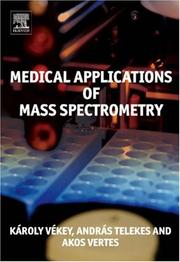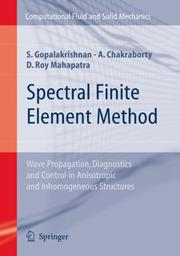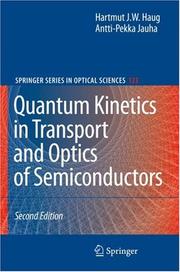| Listing 1 - 6 of 6 |
Sort by
|

ISBN: 1281076961 9786611076962 0080554652 0444519807 9780444519801 9780080554655 9781281076960 6611076964 Year: 2008 Publisher: Amsterdam Boston Elsevier
Abstract | Keywords | Export | Availability | Bookmark
 Loading...
Loading...Choose an application
- Reference Manager
- EndNote
- RefWorks (Direct export to RefWorks)
Mass spectrometry is fast becoming an indispensable field for medical professionals. The mass spectrometric analysis of metabolites and proteins promises to revolutionize medical research and clinical diagnostics. As this technology rapidly enters the medical field, practicing professionals and students need to prepare to take full advantage of its capabilities. Medical Applications of Mass Spectrometry addresses the key issues in the medical applications of mass spectrometry at the level appropriate for the intended readership. It will go a long way to help the utilization of mass
Mass spectrometry. --- Spectrum analysis --- Diagnostic use. --- Mass spectra --- Mass spectrograph --- Mass spectroscopy --- Mass spectrum analysis --- Diagnosis, Laboratory --- Mass (Physics) --- Nuclear spectroscopy
Book
ISBN: 9780470057711 Year: 2008 Publisher: England John Wiley & Sons Ltd.
Abstract | Keywords | Export | Availability | Bookmark
 Loading...
Loading...Choose an application
- Reference Manager
- EndNote
- RefWorks (Direct export to RefWorks)
Chemistry, Analytic --- Mass spectrometry. --- Quantitative. --- Mass spectrometry --- Mass spectra --- Mass spectrograph --- Mass spectroscopy --- Mass spectrum analysis --- Mass (Physics) --- Nuclear spectroscopy --- Spectrum analysis --- Quantitative analysis --- Quantitative chemical analysis --- Quantitative --- Quantitative analytical chemistry --- Analysis, Chemical --- Analytic chemistry --- Chemical analysis --- Chemistry
Book
ISBN: 1597453986 1588299716 Year: 2008 Publisher: Totowa, NJ : Humana Press : Imprint: Humana,
Abstract | Keywords | Export | Availability | Bookmark
 Loading...
Loading...Choose an application
- Reference Manager
- EndNote
- RefWorks (Direct export to RefWorks)
As the emerging field of proteomics continues to expand at an extremely rapid rate, the relative quantification of proteins, targeted by their function, becomes its greatest challenge. Complex analytical strategies have been designed that allow comparative analysis of large proteomes, as well as in depth detection of the core proteome or the interaction network of a given protein of interest. In Functional Proteomics: Methods and Protocols, expert researchers describe the latest protocols being developed to address the problems encountered in high-throughput proteomics projects, with emphasis on the factors governing the technical choices for given applications. The case studies within the volume focus on the following three crucial aspects of the experimental design: 1) the strategy used for the selection, purification and preparation of the sample to be analyzed by mass spectrometry, 2) the type of mass spectrometer used and the type of data to be obtained from it, and 3) the method used for the interpretation of the mass spectrometry data and the search engine used for the identification of the proteins in the different types of sequence data banks available. As a part of the highly successful Methods in Molecular Biology™ series, the chapters compile step-by-step, readily reproducible laboratory protocols, lists of the necessary materials and reagents, and tips on troubleshooting and avoiding known pitfalls. Comprehensive and cutting-edge, Functional Proteomics: Methods and Protocols is an ideal resource for all scientists pursuing this developing field and its multitudinous data.
Biochemistry. --- Proteomics. --- Mass spectrometry. --- Biochemistry, general. --- Protein Science. --- Mass Spectrometry. --- Molecular biology --- Proteins --- Biological chemistry --- Chemical composition of organisms --- Organisms --- Physiological chemistry --- Biology --- Chemistry --- Medical sciences --- Mass spectra --- Mass spectrograph --- Mass spectroscopy --- Mass spectrum analysis --- Mass (Physics) --- Nuclear spectroscopy --- Spectrum analysis --- Composition
Book
ISBN: 1281860786 9786611860783 1402088116 1402088108 1402088094 Year: 2008 Publisher: Dordrecht, Netherlands : Springer,
Abstract | Keywords | Export | Availability | Bookmark
 Loading...
Loading...Choose an application
- Reference Manager
- EndNote
- RefWorks (Direct export to RefWorks)
Mass spectrometry (MS) along with its hyphenated techniques is capable of high throughput, sensitivity, accuracy and selectivity for the analysis of structure and composition of almost any product. Like in electrophoresis, MS separates mo- cules based on the mass-to-charge ratio. In case of gel electrophoresis (SDS- PAGE), a well-known and efficient bioanalytical technique, proteins bear negative charges but have the same charge density, so proteins are separated according to their size. Similarly, in case of MS analysis, proteins carry the same charge, and are separated by their molecular weight. Unlike SDS-PAGE, however, modern ultra high resolution MS discerns very small mass differences and can resolve and completely identify in a single experiment species of the same nominal mass in complex biological mixtures. Consequently, MS can be used for the structural characterization, identification and sensitive detection of mixtures of biomolecules or for assessing the quality of isolated proteins (purity, integrity, or post-translational modifications, for example), carbohydrates, nucleic acids, drugs, metabolites, pollutants etc. In the post-genome era, MS is continuously developing as one of the most re- able analytical method for elucidating the structure of molecules originating from various biological matrices. The potential of MS for high-sensitive structural a- lyses became unsurpassable after the introduction of electrospray (ESI) and matrix assisted laser/desorption ionization (MALDI) methods, on one hand, and the pos- bility to deduce in detail unknown biopolymer structures by highly accurate mo- cular mass measurement followed by sequencing using dissociation techniques based on multiple stage MS, on the other.
Mass spectrometry. --- Chemistry. --- Analytical chemistry. --- Life sciences. --- Biochemistry. --- Mass Spectrometry. --- Biochemistry, general. --- Life Sciences, general. --- Analytical Chemistry. --- Physical sciences --- Mass spectra --- Mass spectrograph --- Mass spectroscopy --- Mass spectrum analysis --- Mass (Physics) --- Nuclear spectroscopy --- Spectrum analysis --- Biological chemistry --- Chemical composition of organisms --- Organisms --- Physiological chemistry --- Biology --- Chemistry --- Medical sciences --- Biosciences --- Sciences, Life --- Science --- Analysis, Chemical --- Analytical chemistry --- Chemical analysis --- Metallurgical analysis --- Mineralogy, Determinative --- Composition --- Analytical biochemistry. --- Analytic biochemistry --- Biochemistry --- Chemistry, Analytic --- Bioanalytic chemistry --- Bioanalytical chemistry --- Analytic chemistry

ISBN: 1281140031 9786611140038 1846283566 1846283558 1849965870 Year: 2008 Publisher: London : Springer,
Abstract | Keywords | Export | Availability | Bookmark
 Loading...
Loading...Choose an application
- Reference Manager
- EndNote
- RefWorks (Direct export to RefWorks)
In recent times, the use of composites and functionally graded materials (FGMs) in structural applications has increased. FGMs allow the user to design materials for a specified functionality and therefore have numerous uses in structural engineering. However, the behavior of these structures under high-impact loading is not well understood. Spectral Finite Element Method: Wave Propagation, Diagnostics and Control in Anisotropic and Inhomogeneous Structures focuses on some of the wave propagation and transient dynamics problems with these complex media which had previously been thought unmanageable. By using state-of-the-art computational power, the Spectral Finite Element Method (SFEM) can solve many practical engineering problems. This book is the first to apply SFEM to inhomogeneous and anisotropic structures in a unified and systematic manner. The authors discuss the different types of SFEM for regular and damaged 1-D and 2-D waveguides, various solution techniques, different methods of detecting the presence of damages and their locations, and different methods available to actively control the wave propagation responses. The theory is supported by tables, figures and graphs; all the numerical examples are designed to bring out the essential wave behavior in these complex structures. Some case studies based on real-world problems are also presented. This book is intended for senior undergraduate students and graduate students studying wave propagation in structures, smart structures, spectral finite element method and structural health monitoring. Readers will gain a complete understanding of how to formulate a spectral finite element; learn about wave behavior in inhomogeneous and anisotropic media; and, discover how to design some diagnostic tools for monitoring the health or integrity of a structure. The book will also be of value to researchers and practicing engineers in structural integrity.
Engineering. --- Mass spectrometry. --- Mechanics. --- Computational intelligence. --- Mechanics, Applied. --- Structural mechanics. --- Building --- Building. --- Construction. --- Engineering, Architectural. --- Building Construction. --- Structural Mechanics. --- Mass Spectrometry. --- Theoretical and Applied Mechanics. --- Computational Intelligence. --- Architectural engineering --- Buildings --- Construction --- Construction science --- Engineering, Architectural --- Structural design --- Structural engineering --- Architecture --- Construction industry --- Structural mechanics --- Structures, Theory of --- Applied mechanics --- Engineering, Mechanical --- Engineering mathematics --- Intelligence, Computational --- Artificial intelligence --- Soft computing --- Classical mechanics --- Newtonian mechanics --- Physics --- Dynamics --- Quantum theory --- Mass spectra --- Mass spectrograph --- Mass spectroscopy --- Mass spectrum analysis --- Mass (Physics) --- Nuclear spectroscopy --- Spectrum analysis --- Industrial arts --- Technology --- Design and construction. --- Design and construction --- Wave-motion, Theory of. --- Finite element method. --- Spectral theory (Mathematics) --- Structural analysis (Engineering) --- Anisotropy --- Mathematical models. --- Anisotropic crystals --- Crystallography --- Matter --- Functional analysis --- Hilbert space --- Measure theory --- Transformations (Mathematics) --- FEA (Numerical analysis) --- FEM (Numerical analysis) --- Finite element analysis --- Numerical analysis --- Isogeometric analysis --- Undulatory theory --- Mechanics --- Properties --- Mechanics, applied. --- Building Construction and Design. --- Solid Mechanics. --- Classical Mechanics. --- Buildings—Design and construction.

ISBN: 1281139246 9786611139247 354073564X 3540735615 3642092691 Year: 2008 Volume: 123 Publisher: Berlin ; New York : Springer,
Abstract | Keywords | Export | Availability | Bookmark
 Loading...
Loading...Choose an application
- Reference Manager
- EndNote
- RefWorks (Direct export to RefWorks)
Nanoscale miniaturization and femtosecond laser-pulse spectroscopy require a quantum mechanical description of the carrier kinetics that goes beyond the conventional Boltzmann theory. On these extremely short length and time scales the electrons behave like partially coherent waves. This monograph deals with quantum kinetics for transport in low-dimensional microstructures and for ultra-short laser pulse spectroscopy. The nonequilibrium Green function theory is described and used for the derivation of the quantum kinetic equations. Numerical methods for the solution of the retarded quantum kinetic equations are discussed and results are presented for high-field transport and for mesoscopic transport phenomena. Quantum beats, polarization decay, and non-Markovian behaviour are treated for femtosecond spectroscopy on a microscopic basis. Since the publishing of the first edition in 1996 the nonequilibrium Green function technique has been applied to a large number of new research topics, and the revised edition introduces the reader to some of these areas, such as molecular electronics, noise calculations, build-up of screening and polaron correlations, and non-Markovian relaxation, among others. Connection to recent experiments is made, and it is emphasized how the quantum kinetic theory is essential in their interpretation.
Semiconductors --- Green's functions. --- Quantum theory. --- Optical properties. --- Quantum dynamics --- Quantum mechanics --- Quantum physics --- Physics --- Mechanics --- Thermodynamics --- Functions, Green's --- Functions, Induction --- Functions, Source --- Green functions --- Induction functions --- Source functions --- Differential equations --- Potential theory (Mathematics) --- Mass spectrometry. --- Elementary Particles, Quantum Field Theory. --- Classical Electrodynamics. --- Mass Spectrometry. --- Complex Systems. --- Condensed Matter Physics. --- Optics, Lasers, Photonics, Optical Devices. --- Mass spectra --- Mass spectrograph --- Mass spectroscopy --- Mass spectrum analysis --- Mass (Physics) --- Nuclear spectroscopy --- Spectrum analysis --- Elementary particles (Physics). --- Quantum field theory. --- Optics. --- Electrodynamics. --- Statistical physics. --- Dynamical systems. --- Condensed matter. --- Lasers. --- Photonics. --- New optics --- Optics --- Light amplification by stimulated emission of radiation --- Masers, Optical --- Optical masers --- Light amplifiers --- Light sources --- Optoelectronic devices --- Nonlinear optics --- Optical parametric oscillators --- Condensed materials --- Condensed media --- Condensed phase --- Materials, Condensed --- Media, Condensed --- Phase, Condensed --- Liquids --- Matter --- Solids --- Dynamical systems --- Kinetics --- Mathematics --- Mechanics, Analytic --- Force and energy --- Statics --- Mathematical statistics --- Dynamics --- Light --- Relativistic quantum field theory --- Field theory (Physics) --- Quantum theory --- Relativity (Physics) --- Elementary particles (Physics) --- High energy physics --- Nuclear particles --- Nucleons --- Nuclear physics --- Statistical methods
| Listing 1 - 6 of 6 |
Sort by
|

 Search
Search Feedback
Feedback About UniCat
About UniCat  Help
Help News
News